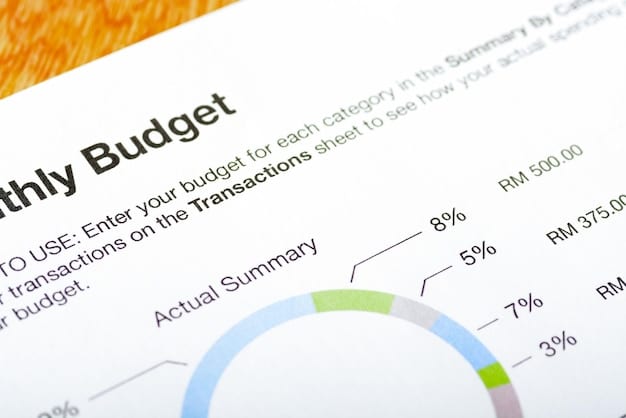Master 50/30/20 Budget: Your 2025 Income Guide

Achieving financial stability in 2025 necessitates Mastering the 50/30/20 Budget: A 2025 Guide to Allocating Your Income Effectively, a straightforward method for dividing income into needs, wants, and savings to foster lasting financial health.
As we navigate 2025, the art of personal finance is less about restriction and more about strategic allocation. Mastering the 50/30/20 Budget: A 2025 Guide to Allocating Your Income Effectively offers a robust, yet flexible framework to ensure your financial aspirations don’t just remain dreams but become tangible realities. This guide unpacks how this renowned budgeting rule can be your cornerstone for fiscal success.
Understanding the Core Principles of the 50/30/20 Rule
The 50/30/20 budgeting rule is a simple yet powerful guideline for managing your money. It suggests dividing your after-tax income into three main categories: 50% for needs, 30% for wants, and 20% for savings and debt repayment. This structure aims to provide a clear roadmap for financial health without overly restricting your lifestyle. It’s a method that promotes balance, allowing you to enjoy life while steadily building your financial future.
While the percentages are fixed, understanding what truly falls into each category is crucial for effective implementation. Misclassifying an expense can throw off your entire budget, leading to frustration and potential financial setbacks. Therefore, a clear, well-defined understanding of each component is the bedrock of successful budgeting with this rule.
Defining Your Needs: The Non-Negotiables
Needs are essential expenses that you cannot reasonably live without. These are the costs that keep a roof over your head, food on your table, and ensure your basic well-being. Identifying these core expenses is the first critical step in applying the 50/30/20 budget effectively.
- Housing: Rent or mortgage payments, property taxes, and home insurance.
- Utilities: Electricity, water, gas, and essential internet services.
- Transportation: Car payments, public transit fares, gas, and car insurance necessary for work or daily life.
- Groceries: Basic food items needed for sustenance and healthy living.
- Healthcare: Insurance premiums, necessary prescriptions, and essential medical care.
Carefully distinguishing between a “need” and a “want” can be challenging. For example, while food is a definite need, dining out frequently falls under “wants.” The goal here is to cover the bare minimum required for a stable existence, ensuring that half of your income is dedicated to these foundational costs.
Categorizing Your Wants: Lifestyle Enhancements
Wants are discretionary expenses that improve your quality of life but are not strictly necessary for survival. These are the things that bring enjoyment, convenience, or comfort. The 30% allocation for wants allows for flexibility and personal choice, preventing your budget from feeling overly restrictive.
It’s important to recognize that wants are subjective and vary from person to person. What one individual considers a want, another might see as a necessity for their unique lifestyle. The key is to be honest with yourself about what truly falls into this category and how much you’re willing to spend on it.
- Entertainment: Streaming services, movies, concerts, and hobbies.
- Dining Out: Restaurant meals, coffee shop visits, and take-out.
- Travel: Vacation expenses, weekend getaways, and leisure trips.
- Shopping: New clothes, gadgets, and non-essential home decor.
- Subscriptions: Gym memberships, premium apps, and magazine subscriptions.
The 30% for wants is your opportunity to indulge responsibly. It ensures that your budget isn’t just about survival, but also about enjoying the fruits of your labor. Balancing these desires with your financial goals is where the true mastery of this budget comes into play, leading to sustainable financial habits.
Allocating for Savings and Debt: Building Your Future
The final 20% of your income is dedicated to financial growth and security. This portion is crucial for building wealth, achieving long-term goals, and creating a safety net for unexpected events. It encapsulates savings, investments, and accelerated debt repayment, directly impacting your financial future.
This category is perhaps the most forward-looking aspect of the 50/30/20 budget. It’s where you actively work towards financial independence and freedom from debt. Prioritizing this 20% ensures that you’re not just living for today, but also planning wisely for tomorrow.
- Emergency Fund: Savings for unexpected expenses like job loss or medical emergencies.
- Retirement Savings: Contributions to 401(k)s, IRAs, or other retirement accounts.
- Debt Repayment: Paying down high-interest debts faster than the minimums, such as credit card debt or student loans.
- Investment: Contributions to brokerage accounts for long-term wealth growth.
- Targeted Savings: Funds for a down payment on a house, a new car, or a significant purchase.
Consistently allocating this 20% is where many people see the most significant long-term impact. It’s a deliberate choice to prioritize your future self, solidifying your financial foundation and paving the way for larger life goals.
Implementing the 50/30/20 Budget in 2025: A Step-by-Step Approach
Embarking on the 50/30/20 budget in 2025 requires a structured approach. It’s not enough to understand the categories; you must actively apply them to your income and expenses. This section outlines a step-by-step guide to seamlessly integrate this powerful budgeting method into your financial life.
The journey begins with a thorough understanding of your current financial landscape, followed by a meticulous classification of your spending. The goal is to move from theoretical knowledge to practical application, making the budget a living document that adapts to your financial realities.
Step 1: Calculate Your After-Tax Income
Your after-tax income, also known as your net income, is the total amount of money you receive in your paycheck after all deductions (taxes, health insurance premiums, retirement contributions, etc.) have been taken out. This is the foundational number for your 50/30/20 budget.
It’s crucial to use your net income, not your gross income, as this rule applies to the money you actually have available to spend and save. For those with fluctuating incomes, consider using an average of your income over the past few months to get a realistic figure. This initial calculation sets the stage for accurate budgeting.
Step 2: Track and Categorize Your Expenses
For a few weeks, or even a month, meticulously track every single dollar you spend. This step is critical for understanding where your money is actually going. Many find this eye-opening, as it reveals spending habits they weren’t consciously aware of.

Once you have a clear picture of your spending, categorize each expense as either a need, a want, or a contribution to savings/debt repayment. Be honest with yourself during this process; remember, the goal is clarity and accuracy, not self-judgment. This data will inform where adjustments need to be made.
Step 3: Adjust Your Spending to Fit the Percentages
Based on your tracking and categorization, you’ll likely find areas where your spending doesn’t align perfectly with the 50/30/20 rule. This step involves making deliberate adjustments. If your needs are consuming more than 50%, you might need to find ways to reduce these core expenses.
If your wants are exceeding 30%, identify discretionary spending that can be cut back. This isn’t about deprivation, but rather about mindful spending that aligns with your financial goals. Lastly, ensure that a solid 20% is consistently allocated towards savings and debt. This might mean reallocating funds from your “wants” category.
Step 4: Automate Your Savings
One of the most effective strategies for adhering to the 20% savings rule is automation. Set up automatic transfers from your checking account to your savings, investment, or debt repayment accounts immediately after you get paid. This ensures that your savings are prioritized before you even have a chance to spend the money.
Automating your savings removes the temptation to spend that money elsewhere and builds consistency, which is key to long-term financial success. This “pay yourself first” mentality is a cornerstone of effective personal finance and significantly boosts your chances of reaching your financial goals.
Step 5: Regularly Review and Adjust Your Budget
A budget is not a static document; it’s a living tool that should evolve with your life. Regularly review your 50/30/20 budget—monthly or quarterly is usually sufficient—to ensure it still aligns with your income, expenses, and financial goals. Life changes, and your budget should reflect those changes.
Whether it’s a new job, a change in family structure, or an unexpected expense, flexibility is key. Don’t be afraid to tweak the percentages or re-evaluate your categories as circumstances change. The goal is to maintain a budget that supports your financial well-being, not to rigidly adhere to numbers that no longer serve you.
Navigating Challenges and Optimizing Your Budget in 2025
Even with a well-defined structure like the 50/30/20 rule, challenges can arise. Unexpected expenses, fluctuating incomes, or the temptation to overspend on wants can derail your progress. This section explores common hurdles and offers proactive strategies to overcome them, ensuring your budget remains effective and resilient throughout 2025.
Optimizing your budget means not just sticking to the numbers, but also finding smarter ways to manage your money within those parameters. It involves strategic thinking, creative solutions, and a commitment to continuous improvement in your financial practices.
Addressing Income Fluctuations
For those with unpredictable incomes, the 50/30/20 rule can seem daunting. The key is to adapt the percentages to your reality. Consider building a buffer by saving more during high-income periods to cover leaner months. An emergency fund is particularly vital here, providing stability when income dips.
Another approach is to base your budget on your lowest expected income, treating any additional income as a bonus that can be allocated directly to savings or debt repayment. This conservative strategy ensures you always meet your needs and savings goals, even when earnings are low.
Dealing with High-Interest Debt
If a significant portion of your income is consumed by high-interest debt payments, it might be challenging to allocate a full 20% to savings. In such cases, consider temporarily rebalancing your percentages. You might allocate more than 20% to debt repayment until the high-interest liabilities are under control.
Options like the debt snowball or debt avalanche methods can accelerate repayment. Once high-interest debts are eliminated, you can revert to the standard 50/30/20 breakdown, seamlessly transitioning back to maximizing your savings and investments. This temporary deviation is a strategic move, not a budget failure.
Reducing “Needs” to Free Up Funds
If your needs consistently exceed 50% of your income, it might be time to critically evaluate these essential expenses. This could involve exploring options like refinancing your mortgage for a lower interest rate, negotiating utility bills, or finding more affordable housing. Even small adjustments can make a significant difference.
Review subscriptions that masquerade as needs but are actually wants, or find ways to reduce transportation costs, such as carpooling or using public transport more often. The goal is to bring your essential spending in line with the 50% target, freeing up more funds for your wants and savings.
Mindful Spending on “Wants”
The 30% allocated to wants is where many people fall off track. It’s easy to justify discretionary spending, but mindfully managing this category is crucial. Before making a “want” purchase, take a moment to consider if it aligns with your overall financial goals or if that money could be better used elsewhere.

Implement a “waiting period” for larger want purchases to avoid impulse buying. Differentiate between occasional indulgences and habitual overspending. The 30% is for enjoyment, but within reason, ensuring it doesn’t encroach on your needs or future savings.
Advanced Strategies for the 50/30/20 Rule in 2025
Once you’ve mastered the basics of the 50/30/20 budget, you can explore advanced strategies to optimize your financial journey in 2025. These techniques aim to maximize your savings, accelerate wealth building, and provide greater financial resilience. Moving beyond the standard application ensures your budget works smarter for you.
Advanced strategies are about fine-tuning your financial approach, looking for opportunities to amplify the benefits of the 50/30/20 rule. This involves strategic thinking about investments, taxes, and leveraging your budget for larger financial milestones.
Leveraging Digital Tools and Apps
In 2025, technology offers an array of tools to simplify budgeting. Apps and software can help you track spending automatically, categorize transactions, and visualize your financial progress in real-time. Look for platforms that integrate with your bank accounts and credit cards to provide a holistic view of your finances.
Many budgeting apps can also send alerts when you’re approaching your spending limits in a category, helping you stay on track. Automating the tracking process frees up mental energy, allowing you to focus on strategic financial decisions rather than manual data entry.
Optimizing Your Savings and Investments
Don’t just save; save smartly. For the 20% allocated to savings, consider diversifying your savings vehicles. Beyond a traditional savings account for your emergency fund, explore high-yield savings accounts that offer better returns. For long-term goals like retirement, maximize contributions to tax-advantaged accounts like 401(k)s and IRAs.
If you’ve maxed out those options, consider a diversified investment portfolio through a brokerage account. Understanding your risk tolerance and investment horizons is key. The goal is to make your 20% work as hard as possible for your future, leveraging compound interest for significant growth over time.
Integrating Financial Goals Beyond the Core Rule
The 50/30/20 rule is a fantastic framework, but it can also be adapted to accommodate larger, specific financial goals. For instance, if you’re saving for a down payment on a house, you might temporarily shift more from your “wants” category into a dedicated savings fund. This doesn’t break the rule but flexes it strategically.
This flexibility allows the budget to remain relevant and motivating as your life and financial priorities evolve. It’s about using the framework as a guide, not a rigid prison, providing enough adaptability to chase significant life milestones.
Psychological Aspects of Budgeting and Financial Wellness
Budgeting is as much a psychological exercise as it is a mathematical one. Our relationship with money, our habits, and our emotional responses to spending and saving play a significant role in our financial success. In 2025, cultivating a healthy financial mindset is key to making any budget method, including the 50/30/20 rule, truly stick.
Understanding these underlying psychological factors can help you overcome common budgeting pitfalls and develop more sustainable financial habits. It’s about being aware of your money triggers and building resilience against financial temptations.
Building Financial Discipline and Resisting Temptation
Discipline is the cornerstone of any successful budget. It means making conscious choices about your spending, even when faced with immediate gratification. This often involves resisting impulse purchases and delaying satisfaction for long-term gains. One strategy is to practice mindful spending by pausing before making a purchase and asking yourself if it aligns with your budget and goals.
Creating clear boundaries between “needs” and “wants” helps reinforce this discipline. External accountability, such as discussing your budget with a trusted friend or partner, can also provide extra motivation and support to stay on track. Remember, financial discipline is a muscle that gets stronger with practice.
Overcoming Budget Burnout
Budgeting can sometimes feel restrictive, leading to “budget burnout”—a feeling of exhaustion or resentment towards managing your money. To prevent this, ensure your 30% “wants” category is genuinely allowing for enjoyable discretion. Deprivation often leads to abandonment of the budget entirely. Build in small rewards for reaching financial milestones.
Automating aspects of your budget, like savings, can also reduce the mental load. Focus on the positive outcomes and the freedom your budget provides, rather than the perceived limitations. Occasional adjustments to your budget to accommodate an important life event can also prevent burnout, showing that your budget is flexible.
Setting Realistic Expectations and Celebrating Progress
It’s important to set realistic expectations for your budgeting journey. You won’t achieve financial perfection overnight, and there will be times when you deviate from your plan. What matters is how you recover and get back on track. Each small step forward is progress, and worthy of acknowledgment.
Regularly celebrate your budgeting successes, big or small. Paid off a credit card? That’s a victory! Saved an extra $100 this month? Acknowledge it. Celebrating progress provides positive reinforcement and keeps you motivated to continue your financial journey. This balanced approach fosters a more resilient and positive relationship with your money.
Common Misconceptions and Flexibility of the 50/30/20 Rule
While the 50/30/20 budget is a widely embraced framework, it’s often met with certain misconceptions. Some believe it’s too rigid, others that it’s impossible to implement. This section addresses these common misunderstandings and highlights the inherent flexibility of the rule, ensuring you can tailor it effectively to your unique situation in 2025 and beyond.
Recognizing the adaptability of this guideline allows for greater success. It’s not a one-size-fits-all solution, but rather a customizable template that can evolve with your financial life. Understanding its nuances is key to truly ‘mastering’ the method.
“It’s Too Rigid for My Income”
A frequent critique is that the 50/30/20 rule doesn’t account for varying income levels or high cost-of-living areas. While the percentages are a guide, they are not set in stone for every single person. For example, if you live in an extremely expensive city, your “needs” might naturally exceed 50%.
In such cases, the rule acts as an ideal to strive for. You might initially find your needs are 60% and adjust your “wants” down to 20%, maintaining the 20% for savings. The goal is to evaluate where you stand relative to the rule and make gradual, strategic adjustments. It’s a target, not a strict mandate, especially in the initial stages.
“I Can’t Afford to Save 20%”
For some, particularly those with lower incomes or significant debt, saving 20% right away can seem insurmountable. If this is your situation, start small. Even saving 5% or 10% is a crucial first step. The priority is to build the habit of saving consistently, no matter the amount.
As your income increases or debt decreases, you can gradually increase your savings percentage until you reach or even exceed the 20% target. Remember the principle: any saving is better than no saving. The rule provides direction, not rigid limitations, especially when starting your financial journey.
It’s Only for People Who Want to Be Frugal
The 50/30/20 budget is often mistakenly associated with extreme frugality. In reality, it promotes balance. The 30% allocated to “wants” is specifically designed to allow for discretionary spending and enjoying life’s pleasures. It’s about conscious spending, not deprivation.
This budget allows you to spend freely within your “wants” category without guilt, because you know your needs are covered and your future is being secured. It’s a method for mindful indulgence, enabling you to build wealth while still leading a fulfilling lifestyle. It shifts the focus from restriction to strategic allocation and enjoyment.
Future-Proofing Your Finances with the 50/30/20 Rule in 2025
As we advance deeper into 2025, the economic landscape continues to evolve, bringing new challenges and opportunities. The 50/30/20 rule, with its inherent adaptability, serves as an excellent foundation for future-proofing your finances. This section explores how to ensure your budget remains robust and relevant amidst changing financial climates, technology, and personal goals.
Future-proofing means not just reacting to changes, but proactively positioning yourself for long-term financial success. It involves critical thinking beyond the immediate paycheck, considering inflation, economic shifts, and personal growth.
Adapting to Inflation and Economic Shifts
Inflation can quietly erode your purchasing power, making your money buy less over time. Regularly reviewing your “needs” budget becomes crucial during inflationary periods. Are your grocery bills increasing? Have utility costs gone up? Adjust your budget categories to reflect these new realities.
During economic downturns, focusing more on your 20% savings (especially an emergency fund) can provide a vital safety net. Conversely, during periods of economic growth, consider increasing your investment portion within that 20% to capitalize on market opportunities. The 50/30/20 rule is dynamic; its effectiveness lies in your willingness to adapt it to prevailing economic conditions.
Leveraging AI and Financial Technology for Budgeting
The year 2025 will see an even greater integration of AI and advanced financial technology into personal finance. AI-powered budgeting apps can offer personalized spending insights, predict future expenses, and even suggest optimized allocation strategies based on your habits and goals. These tools can automate much of the heavy lifting of budgeting.
Consider adopting these technologies to enhance your 50/30/20 strategy. They can provide a level of precision and insight that manual budgeting often misses, helping you fine-tune your allocations and identify areas for improvement with minimal effort. Embracing these innovations makes budgeting smarter and more efficient.
Planning for Long-Term Goals (Retirement, Homeownership)
The 20% savings component of the 50/30/20 rule is your primary vehicle for long-term goal achievement. Beyond an emergency fund, strategically direct portions of this 20% towards specific aspirations like retirement, a down payment on a house, or your children’s education. Break these large goals into smaller, manageable savings targets.
For retirement, maximize contributions to tax-advantaged accounts. For a home, consider specific savings accounts or investments tailored to those horizons. By tying your 20% allocation to concrete long-term goals, you transform abstract saving into purposeful wealth building, making the path to those future aspirations clearer and more attainable.
| Key Point | Brief Description |
|---|---|
| 🏠 50% for Needs | Covers essential expenses like housing, utilities, groceries, and transportation. |
| 🎉 30% for Wants | Allocated for discretionary spending, lifestyle enhancements, and entertainment. |
| 💰 20% for Savings & Debt | Dedicated to building wealth, emergency funds, investments, and accelerated debt repayment. |
| 🔄 Flexibility & Review | The budget isn’t rigid; adapt it to changes in income, expenses, and financial goals. |
Frequently Asked Questions About the 50/30/20 Budget
If your needs surpass 50%, first identify areas to reduce essential spending, like housing or transportation. If that’s not feasible, temporarily adjust your “wants” category downward to make up the difference, while still prioritizing your 20% for savings. It’s a guideline, not a strict rule in initial stages.
You should review your budget at least once a month, or quarterly. This ensures it remains aligned with your current income, expenses, and financial goals. Life changes, and your budget needs to adapt to reflect significant shifts in your financial landscape, like a new job or major purchase.
Absolutely. For fluctuating incomes, consider basing your budget on your lowest expected monthly income. Allocate any additional earnings directly to savings, debt repayment, or a buffer fund for leaner months. This conservative approach helps maintain stability and consistency in your budgeting efforts.
“Needs” are expenses required for survival and basic living, like rent, health insurance, and essential groceries. “Wants” are discretionary items that improve quality of life but aren’t strictly necessary, such as dining out, entertainment subscriptions, or designer clothes. The distinction helps prioritize spending.
Yes, it’s a versatile framework. While it provides solid guidelines, it’s flexible enough to accommodate various goals. You can adjust the 20% savings portion to prioritize specific objectives like a down payment or aggressive debt repayment, integrating personal financial milestones within the established structure for greater impact.
Conclusion
Mastering the 50/30/20 Budget: A 2025 Guide to Allocating Your Income Effectively provides a clear, actionable path to financial well-being. By thoughtfully categorizing your income into needs, wants, and savings, you gain immense control over your financial destiny. This rule isn’t about rigid restrictions; it’s about conscious choices that empower you to live comfortably today while building a secure future. Implementing this framework, with its inherent flexibility and potential for optimization, equips you to navigate 2025’s financial landscape with confidence and achieve lasting stability and growth. Your financial success begins with a clear, well-managed budget, and the 50/30/20 rule offers precisely that blueprint.





